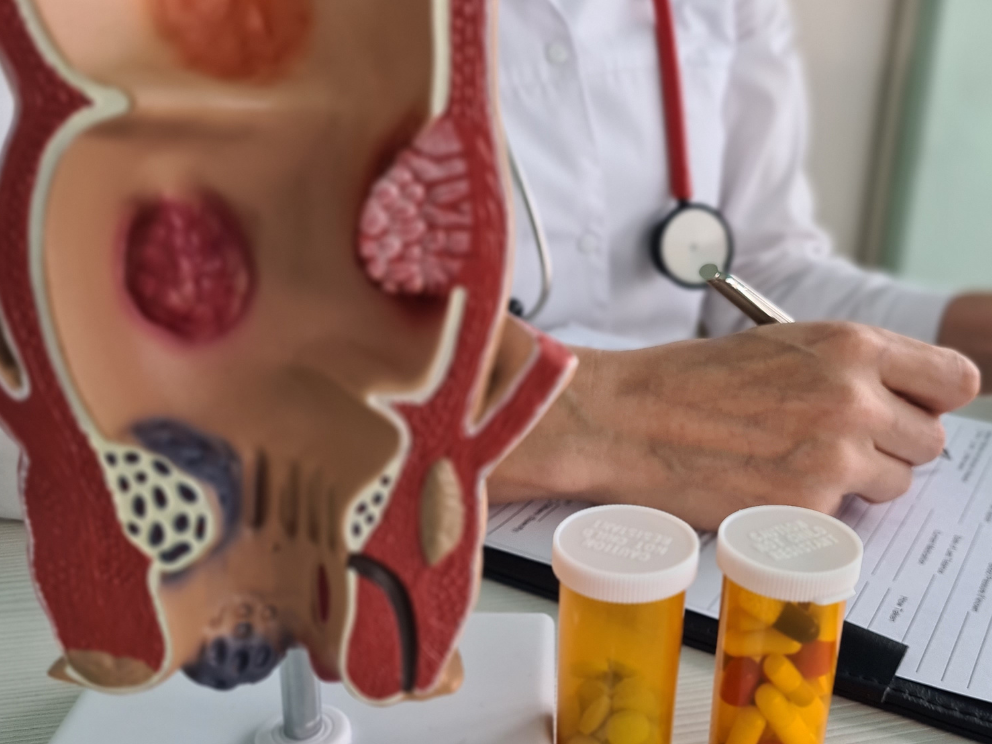Hemorrhoids
What causes hemorrhoids?
There are several conditions which contribute to hemorrhoids:
- prolonged standing
- poor bowel habits
- constipation
- diarrhea
- pregnancy
- obesity
- frequently straining
What are the complications?
- Thrombosis and Pain – Blood clots in the hemorrhoid can cause severe pain and require immediate medical attention.
- Bleeding – Regardless of whether they are internal or external, hemorrhoids can ooze fresh, red blood. Blood dripping from the anus while sitting on the toilet is usually caused by external hemorrhoids. This blood may also be seen soiling the underwear. Fresh blood in the stool is caused by internal hemorrhoids.
- Itching and Irritation – External hemorrhoids can cause itching especially if the area is moist or irritated.
Do hemorrhoids cause cancer?
While hemorrhoids do not cause cancer, both cancer and hemorrhoids can cause rectal bleeding. Rectal bleeding should be considered a serious problem until an exact diagnosis is made, especially in people over age 30 and even more so over age 50.
Can you prevent hemorrhoids?
Implementing the following lifestyle changes can help to prevent hemorrhoids from developing:
- high fiber, bran or roughage diet or use a stool bulking agent
- do not delay or try to prevent having a bowel movement when the urge is present
- avoid straining
- exercise, especially aerobic
- drink plenty of liquids and eat regular meals
- keep the area around the anus clean and dry

What kinds of treatment are available?
There are various types of treatment available depending on their location, problems being caused, and seriousness of condition. In many instances, time and the natural healing process are the only required treatments.When treatment is required, the following general measures are recommended:
- Conservative Treatment
- used for both internal and external hemorrhoids
- keep area clean using a mild soap and avoid vigorous rubbing of the area
- keep anus and hemorrhoids as dry as possible – soft tissue or powder may be used to absorb moisture
- eat a high fiber and roughage diet – fiber retains water in the stool and create soft, bulky stools, this allows easier passage of stools and eliminates straining
- avoid straining to have a bowel movement
- hot Sitz bath – 10-20 minute hot tub bath two to four times a day which provides heat to the area for pain relief and to promote healing
- Ligation
- used in treatment of internal hemorrhoids only
- a rubber band is placed around the base of the hemorrhoid to stop circulation, the hemorrhoid eventually will fall off
- may require repeat treatments
- can be done in the clinic setting
- Infrared or Bipolar Photocoagulation
- used in treatment of internal hemorrhoids only
- an infrared light source or bipolar current is used to coagulate internal hemorrhoid veins
- usually requires more than one treatment
- Surgery is usually recommended in the following instances:
- acute, painful clot of hemorrhoid
- profusely or continually bleeding
- longstanding, irreversible, large hemorrhoids
- when all other options haven’t been successful
- Used in treatment of internal and external hemorrhoids
- Surgical options include conventional surgery and stapled hemorrhoid surgery
Your doctor will evaluate your case to determine the appropriate treatment for you.